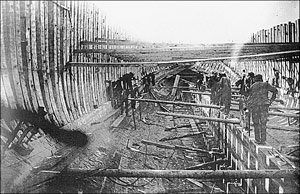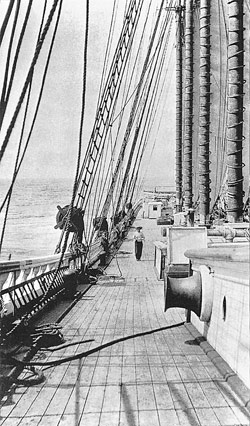 The internal structure of the hull provided much of its strength. This photo shows ships’ carpenters and fasteners at work. The crew standing on the keelson is driving long bolts through the five keelson tiers, the frame floor and into the keel. The men on the left and right are installing ceiling planks. All parts of the vessel had to fit tightly together. The long poles across the keelson were used to force the ceiling strakes into position. Photo Courtesy: Robert Colfer The internal structure of the hull provided much of its strength. This photo shows ships’ carpenters and fasteners at work. The crew standing on the keelson is driving long bolts through the five keelson tiers, the frame floor and into the keel. The men on the left and right are installing ceiling planks. All parts of the vessel had to fit tightly together. The long poles across the keelson were used to force the ceiling strakes into position. Photo Courtesy: Robert Colfer
|
The drama outlined above continues to this day and every participant has left tangible proofs of their time on earth here in Maine. Treasures, these, but not necessarily treasures of gemstones, silver and gold (although those, too, exist in Maine).
For many, anything from past cultures has historical value. Thus, the coral-encrusted bottle hauled up from the ocean depths by a dragger, is a treasure. Maine’s sea, shoreline and even farmlands hold many as-of-yet-undiscovered treasures. And best of all, these don’t require a degree in archaeology and the treasure hunter needn’t search far and wide for a financier. Treasures from Maine’s past are all around us and all we need do is maintain an attentive eye.
Here’s an example of how one person collected a representative sample of artifacts from the people who lived and worked in a Maine, coastal town. In the mid-1950s, this lady bought a small house in Belfast and decided to plant a vegetable garden. Turning over the soil with a spading fork, she noticed an especially round pebble. Picking it up, she saw that it was not a pebble but rather, a clay marble.
Over the years, this small patch of rather fertile soil yielded not only green beans, cucumbers and tomatoes, but also many more marbles, potshards, clay pipes, all with short stubs of stems remaining and of course, a number of coins. The early pipes were made in Europe and brought here by the case, aboard sailing vessels. The clay pipe industry began in England in 1564, the year tobacco was introduced. Early pipes were modeled after those used by the American Indians. Later, hundreds of unique designs were produced.
Some of the earliest examples of imported, clay pipes were found around Maine’s early forts. For example, the museum at the site of old Fort William Henry in Bristol, demolished in 1696, contains numerous examples of early, clay pipes. One coin bears the following inscription: “Confoederatio Helvetica, 1882.” Helvetica translates to something like, “inhabitants of the Alps.” How did this coin arrive in a Belfast garden? Who dropped it, and what was his or her business here?
Time Capsule
Much of what future generations will learn of present-day Maine may well come from advertisements from our time. Magazine and newspaper ads speak volumes about our culture. We, too, can deduce much from similar material from our past. Here’s a scenario, a rather typical one, in which a worker was hired to clean out the top floor of an old building. One item that he found amidst cobwebs and dust was a virtual time capsule from another era.
A broadsheet, or handbill, printed in 1847, proclaims that, “William O. Poor has removed to the new, spacious and central store called Johnson’s Block.” The sheet contains a long list of items offered for sale. These include, “Medicines, clothes, paints and oils, graining brushes, dye stuffs, dyeing drugs, cards, jacks, comb plate, comb clearers, tenter hooks, acids, sperm and lard oil &c. &c.”
Tenter hooks? Really? Who would have imagined that such things were actual items that people used? In fact, tenterhooks were part of the frames once used for stretching and drying cloth. Regarding what people ate in those days, the handbill goes on to list, “Powdered do, leaf do, coffee, tea, black and green, cocoa, saleratus, Zante currents, citron, sultana, box and cask raisins, figs, preserved ginger, soda biscuit, &c.” Saleratus, by the way, was an old-time name for baking soda.
The old broadsheet may not hold much in the way of numerical value, but the light it throws on the customs and lifestyle of people in mid-19th century, coastal Maine is priceless. It is a true treasure. And just think, that since 1847, it languished in the file in an old store, just waiting to be found.
 Cabin boy Bailey makes the long trek from Wyoming’s afterhouse, carrying the remains of a meal back to the galley located in the midship house. Photo by John B. Brooks, courtesy of Captain W.J. Lewis Parker, USCG, Ret. Cabin boy Bailey makes the long trek from Wyoming’s afterhouse, carrying the remains of a meal back to the galley located in the midship house. Photo by John B. Brooks, courtesy of Captain W.J. Lewis Parker, USCG, Ret.
|
Beachcombing
The word “beachcombing,” conjures images of straw-hatted, suntanned people walking along on some tropical beach. But the Maine version carries more interest and contains many more fascinating possibilities.
From the days when Maine’s first inhabitants sat on a beach and tossed oyster and clam shells on ever-growing heaps, to the times when sailing ships dumped their ballast of round-bottomed bottles or perhaps, English flint on our shores, the Maine coast has served as a repository for the treasures of millennia.
The flint piles mentioned above have mostly been found and the flint removed. An intact pile is a true treasure and certainly, some still exist. But small deposits, spread along the rocky shores, are relatively common. Much of the fine flints of Europe are not black, as is our native flint but rather, of a pale brown or amber tone. These made the finest gunflints available.
Another kind of flint, this most assuredly native, originated on Mt. Kineo in the middle of Moosehead Lake. The last glacier to pass this way cropped huge chunks of a waxy-gray flint called, “Kineo rhyolite.” The glacier deposited this flint on the shores of northern Penobscot Bay. On the way, the flint got crushed beneath the massive weight of the ice, leaving specimens ranging in size from large boulders to small bits. Later, the indigenous people recognized the flint as useful for tool making.
Today, walkers strolling the rocky edge of Penobscot Bay find examples of flint that had been “worked,” or faceted, by humans. Unfortunately, wave action has smoothed the edges on most of the stone and it takes a somewhat practiced eye to distinguish a worked bit of flint. Some rhyolite, however, landed above the high-tide line and still, large and medium-sized boulders sit, faceted, with edges so sharp as to cut flesh with the lightest touch.
Beads, too, found their way to beaches up and down the Maine coast. These ancient forms of artwork are difficult to spot, unless the treasure hunter knows the secret of the ants. Ant colonies continually expand and in this process, the insects work zealously to clear their tunnels and chambers of foreign object such as rocks, arrowheads and beads.
So with due caution given to biting ants, try sifting the fine soil from a seaside anthill and keep watch for artifacts, treasures from another time.
Modern Tools
The use of metal detectors was something of a fad in Maine during the 1970s. Everyone was a treasure hunter. Soon, communities enacted ordinances banning the use of these tools. The fad passed, as all fads do and today, metal detectors are no more or less than a useful tool in the neo-treasure hunter’s arsenal.
What passes for one person’s trash often represents someone else’s treasure. For instance, a metal detector once disclosed to the author such treasures as old, wrought-iron pot hooks and even ancient, rust-encrusted horseshoes. These treasures represent a tangible link to the past, a bridge to the people who lived and worked here in another, far-gone time. They are treasures for sure.
The modern, Maine treasure hunter has much to be thankful for. Our state, in its vastness, holds an almost endless store of oddities, curiosities and treasures from the past. History lives and all can take part in it. Good hunting. |





